Abstract
A clinical trial was designed to evaluate the efficacy and safety of cefotaxime, a new semisynthetic, broad-spectrum cephalosporin, in the therapy of community-and hospital-acquired pneumonias. Thirty-nine males (mean age, 65 years) were treated for 41 episodes of pneumonia. Only five patient did not have a serious underlying disease; 15 had two or more significant disorders. Sixty-six percent of these pneumonias were due to Streptococcus pneumoniae or Haemophilus influenzae. The minimal inhibitory concentrations for all bacterial isolates ranged from 0.008 to 4 micrograms/ml. Peak serum cefotaxime levels during therapy ranged from 12 to 124 micrograms/ml 1 h after a 1-g dose. Satisfactory bacteriological and clinical responses were observed in 85% of the cases. Four episodes of pulmonary superinfections due to cefotaxime-resistant gram-negative bacilli were noted, each in a patient being mechanically ventilated. Pseudomonas was involved in each of these superinfections, and three were fatal. No serious toxicity or adverse reaction to cefotaxime was seen. The results of this study suggest that cefotaxime is an affective and well-tolerated new cephalosporin antimicrobial agent for the therapy of pneumonia due to susceptible organisms.
Full text
PDF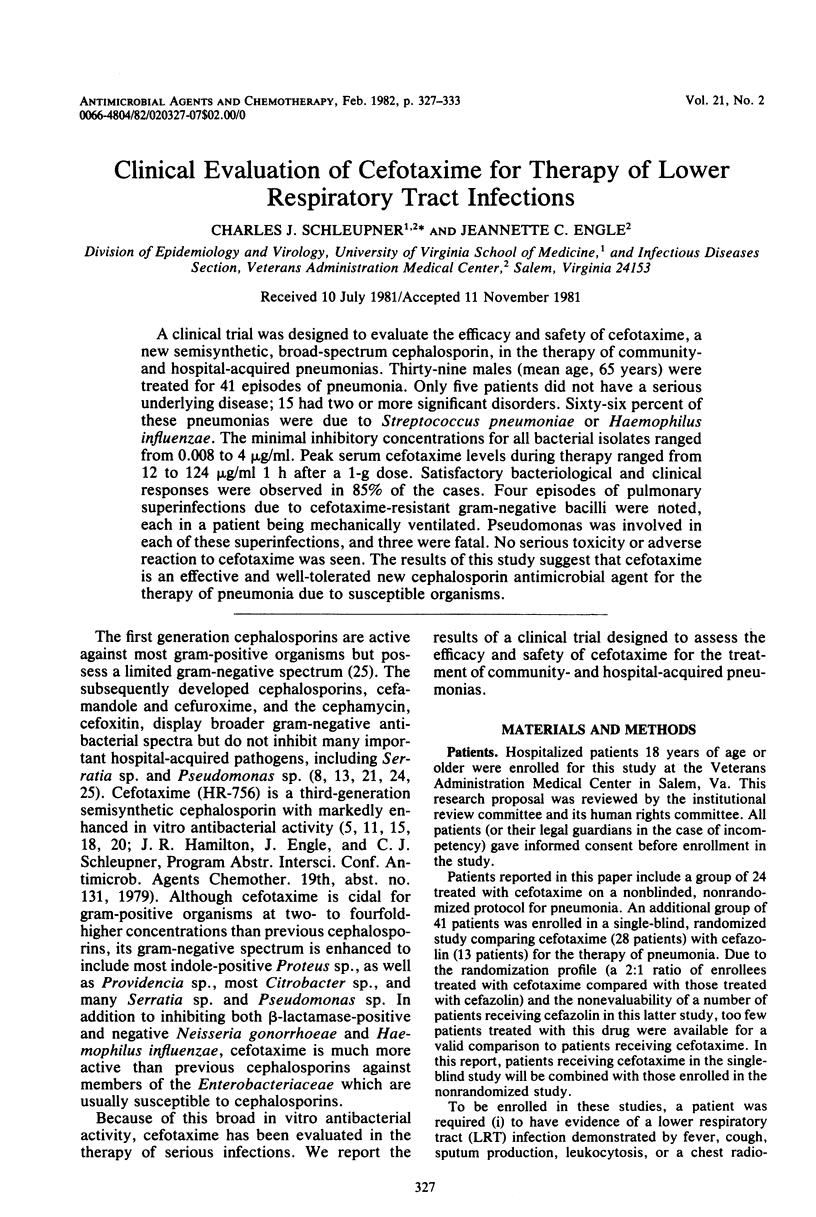
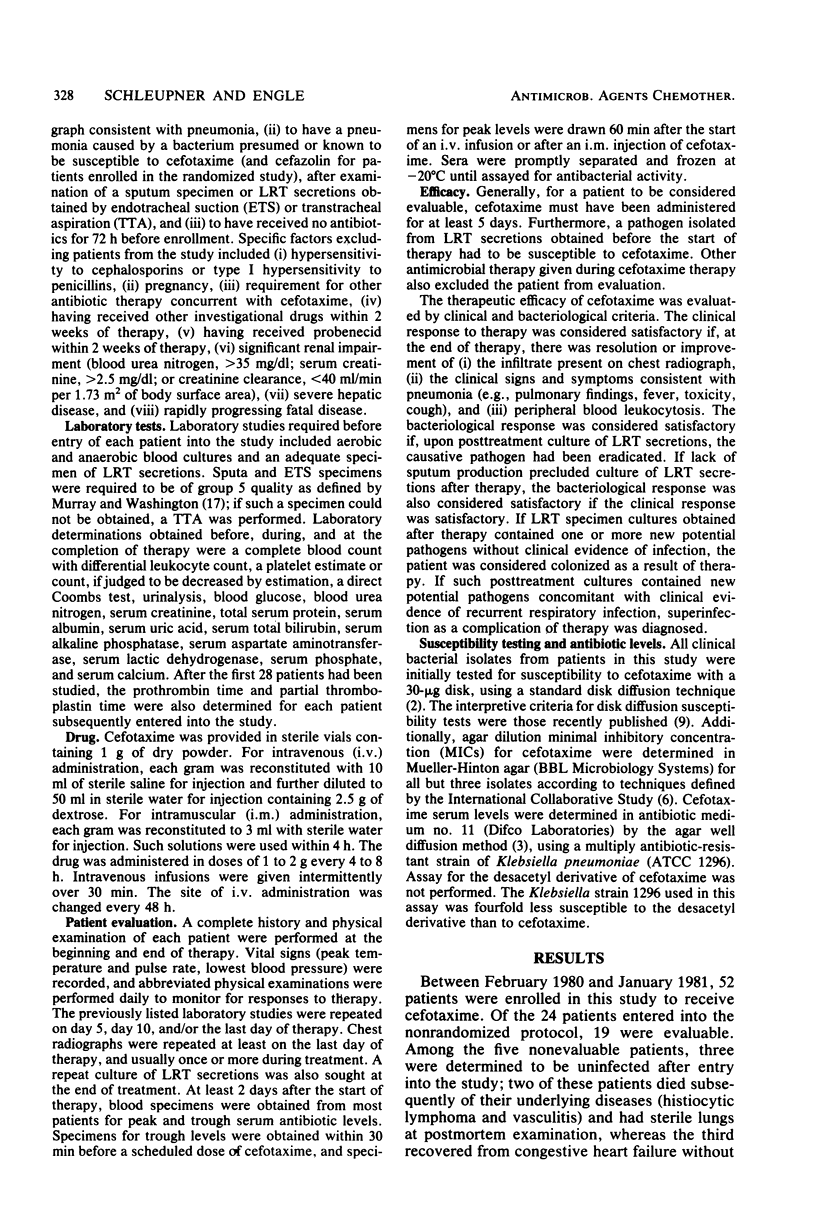
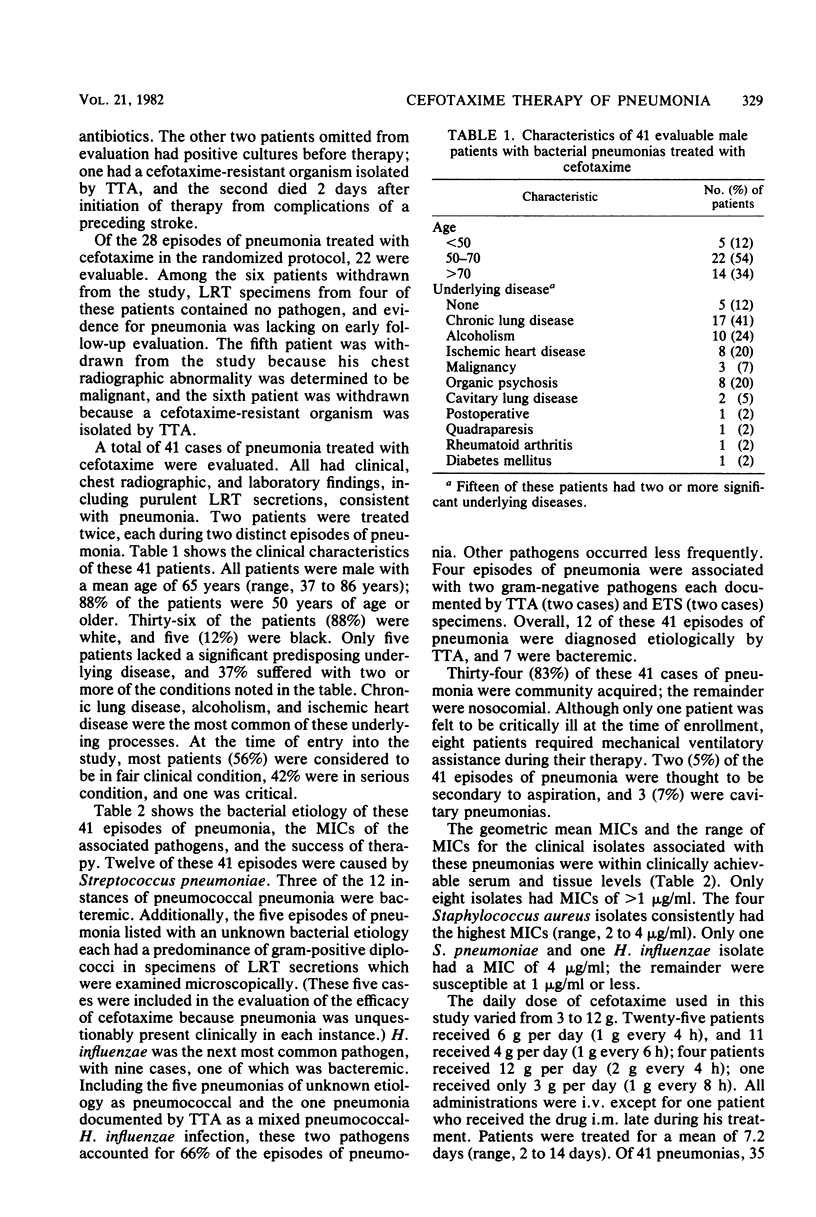
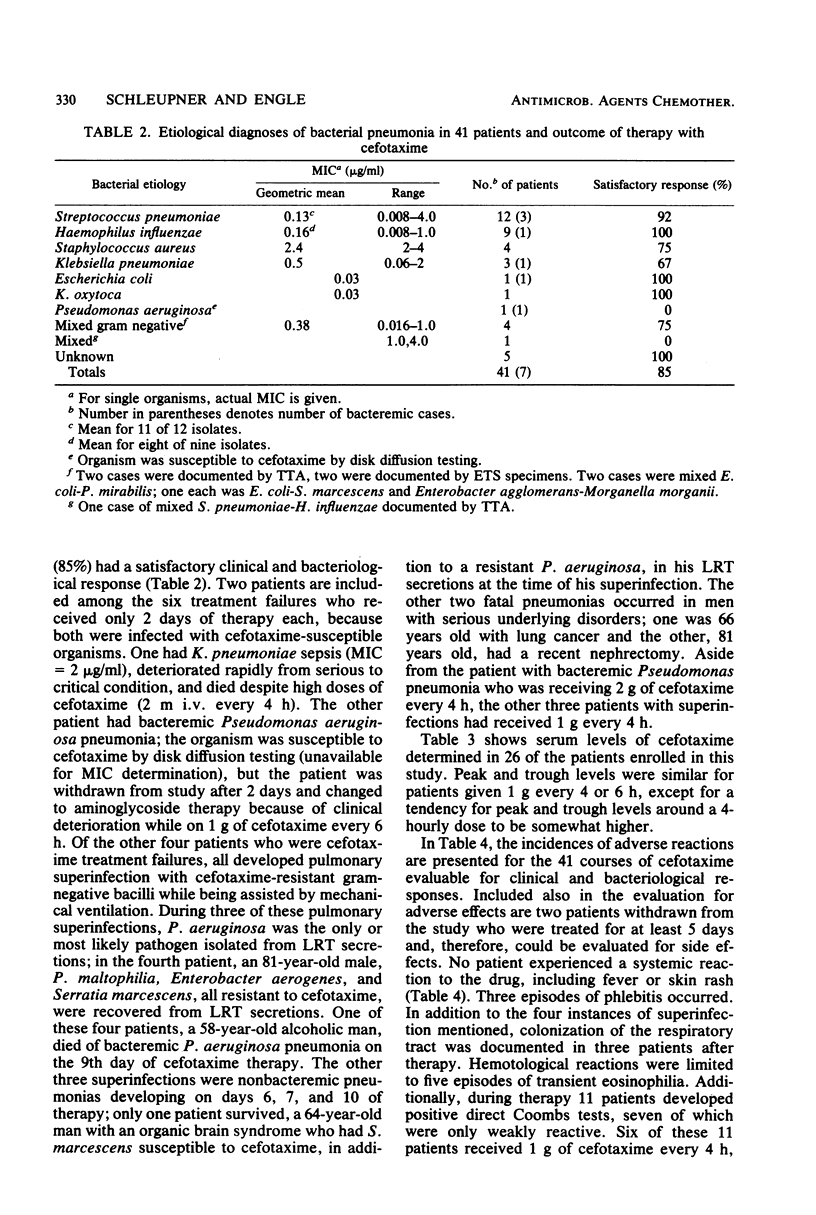
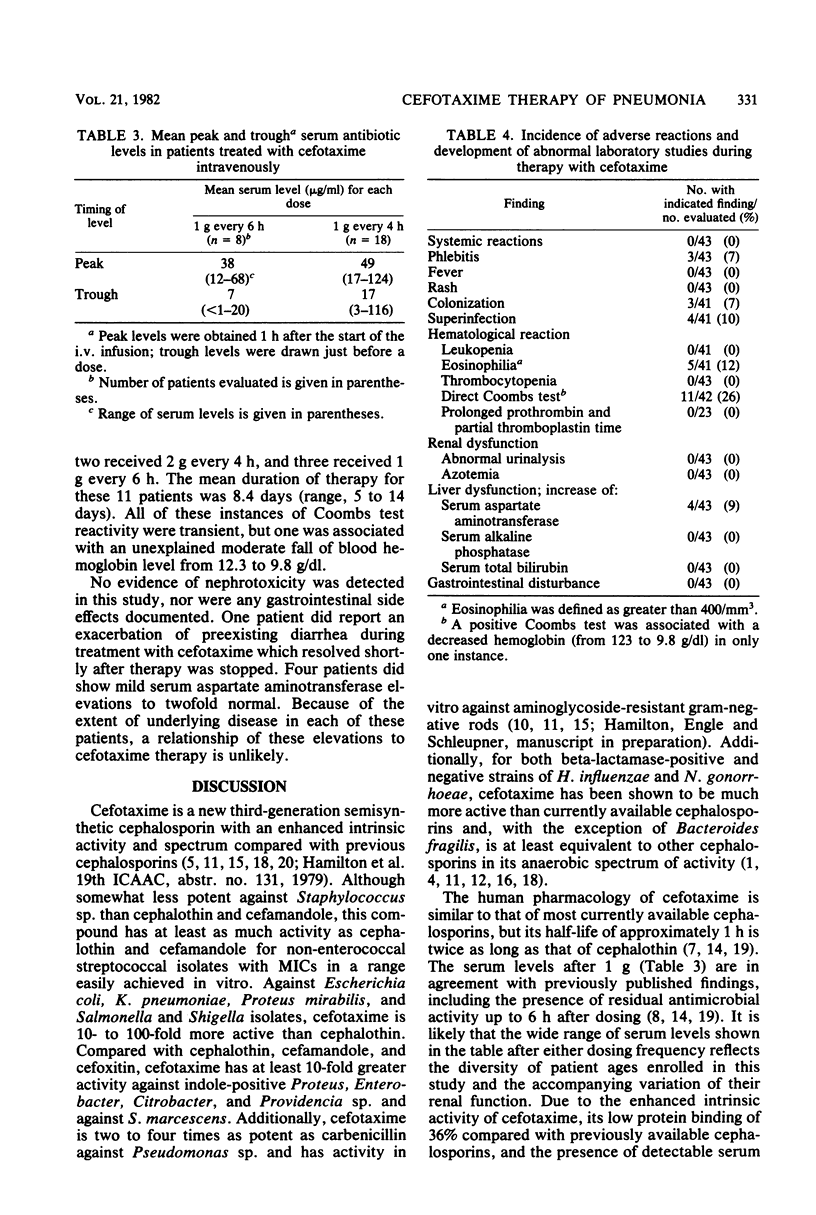
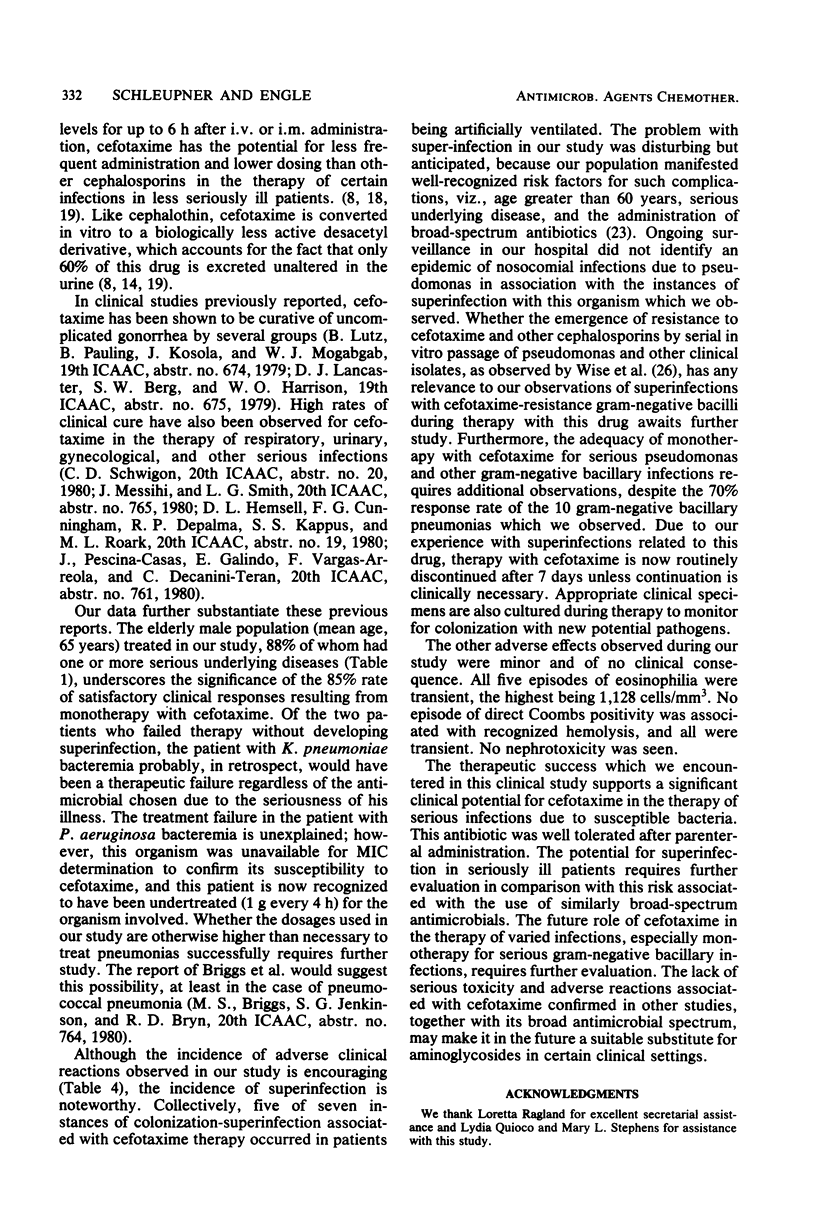
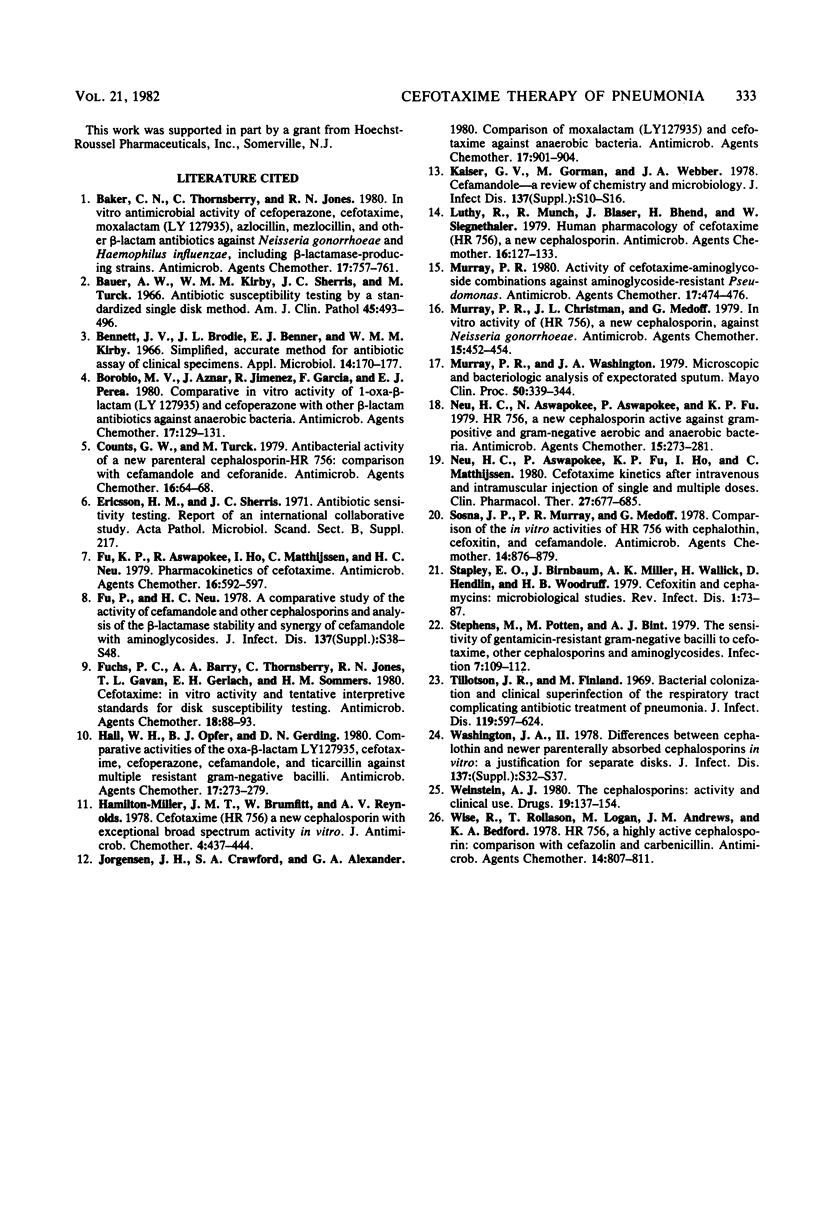
Selected References
These references are in PubMed. This may not be the complete list of references from this article.
- Baker C. N., Thornsberry C., Jones R. N. In vitro antimicrobial activity of cefoperazone, cefotaxime, moxalactam (LY127935), azlocillin, mezlocillin, and other beta-lactam antibiotics against Neisseria gonorrhoeae and Haemophilus influenzae, including beta-lactamase-producing strains. Antimicrob Agents Chemother. 1980 Apr;17(4):757–761. doi: 10.1128/aac.17.4.757. [DOI] [PMC free article] [PubMed] [Google Scholar]
- Bauer A. W., Kirby W. M., Sherris J. C., Turck M. Antibiotic susceptibility testing by a standardized single disk method. Am J Clin Pathol. 1966 Apr;45(4):493–496. [PubMed] [Google Scholar]
- Bennett J. V., Brodie J. L., Benner E. J., Kirby W. M. Simplified, accurate method for antibiotic assay of clinical specimens. Appl Microbiol. 1966 Mar;14(2):170–177. doi: 10.1128/am.14.2.170-177.1966. [DOI] [PMC free article] [PubMed] [Google Scholar]
- Borobio M. V., Aznar J., Jimenez R., Garcia F., Perea E. J. Comparative in vitro activity of 1-oxa-beta-lactam (LY127935) and cefoperazone with other beta-lactam antibiotics against anaerobic bacteria. Antimicrob Agents Chemother. 1980 Feb;17(2):129–131. doi: 10.1128/aac.17.2.129. [DOI] [PMC free article] [PubMed] [Google Scholar]
- Counts G. W., Turck M. Antibacterial activity of a new parenteral cephalosporin--HR 756: comparison with cefamandole and ceforanide. Antimicrob Agents Chemother. 1979 Jul;16(1):64–68. doi: 10.1128/aac.16.1.64. [DOI] [PMC free article] [PubMed] [Google Scholar]
- Ericsson H. M., Sherris J. C. Antibiotic sensitivity testing. Report of an international collaborative study. Acta Pathol Microbiol Scand B Microbiol Immunol. 1971;217(Suppl):1+–1+. [PubMed] [Google Scholar]
- Fu K. P., Aswapokee P., Ho I., Matthijssen C., Neu H. C. Pharmacokinetics of cefotaxime. Antimicrob Agents Chemother. 1979 Nov;16(5):592–597. doi: 10.1128/aac.16.5.592. [DOI] [PMC free article] [PubMed] [Google Scholar]
- Fu K. P., Neu H. C. A comparative study of the activity of cefamandole and other cephalosporins and analysis of the beta-lactamase stability and synergy of cefamandole with aminoglycosides. J Infect Dis. 1978 May;137 (Suppl):S38–S50. doi: 10.1093/infdis/137.supplement.s38. [DOI] [PubMed] [Google Scholar]
- Fuchs P. C., Barry A. L., Thornsberry C., Jones R. N., Gavan T. L., Gerlach E. H., Sommers H. M. Cefotaxime: in vitro activity and tentative interpretive standards for disk susceptibility testing. Antimicrob Agents Chemother. 1980 Jul;18(1):88–93. doi: 10.1128/aac.18.1.88. [DOI] [PMC free article] [PubMed] [Google Scholar]
- Hall W. H., Opfer B. J., Gerding D. N. Comparative activities of the oxa-beta-lactam LY127935, cefotaxime, cefoperazone, cefamandole, and ticarcillin against multiply resistant gram-negative bacilli. Antimicrob Agents Chemother. 1980 Feb;17(2):273–279. doi: 10.1128/aac.17.2.273. [DOI] [PMC free article] [PubMed] [Google Scholar]
- Hamilton-Miller J. M., Brumfitt W., Reynolds A. V. Cefotoxime (HR 756) a new cephalosporin with exceptional broad-spectrum activity in vitro. J Antimicrob Chemother. 1978 Sep;4(5):437–444. doi: 10.1093/jac/4.5.437. [DOI] [PubMed] [Google Scholar]
- Jorgensen J. H., Crawford S. A., Alexander G. A. Comparison of moxalactam (LY127935) and cefotaxime against anaerobic bacteria. Antimicrob Agents Chemother. 1980 May;17(5):901–904. doi: 10.1128/aac.17.5.901. [DOI] [PMC free article] [PubMed] [Google Scholar]
- Kaiser G. V., Gorman M., Webber J. A. Cefamandole---a review of chemistry and microbiology. J Infect Dis. 1978 May;137 (Suppl):S10–S16. doi: 10.1093/infdis/137.supplement.s10. [DOI] [PubMed] [Google Scholar]
- Lüthy R., Münch R., Blaser J., Bhend H., Siegenthaler W. Human pharmacology of cefotaxime (HR 756), a new cephalosporin. Antimicrob Agents Chemother. 1979 Aug;16(2):127–133. doi: 10.1128/aac.16.2.127. [DOI] [PMC free article] [PubMed] [Google Scholar]
- Murray P. R. Activity of cefotaxime-aminoglycoside combinations against aminoglycoside-resistant Pseudomonas. Antimicrob Agents Chemother. 1980 Mar;17(3):474–476. doi: 10.1128/aac.17.3.474. [DOI] [PMC free article] [PubMed] [Google Scholar]
- Murray P. R., Christman J. L., Medoff G. In vitro activity of HR 756, a new cephalosporin, against Neisseria gonorrhoeae. Antimicrob Agents Chemother. 1979 Mar;15(3):452–454. doi: 10.1128/aac.15.3.452. [DOI] [PMC free article] [PubMed] [Google Scholar]
- Murray P. R., Washington J. A. Microscopic and baceriologic analysis of expectorated sputum. Mayo Clin Proc. 1975 Jun;50(6):339–344. [PubMed] [Google Scholar]
- Neu H. C., Aswapokee N., Aswapokee P., Fu K. P. HR 756, a new cephalosporin active against gram-positive and gram-negative aerobic and anaerobic bacteria. Antimicrob Agents Chemother. 1979 Feb;15(2):273–281. doi: 10.1128/aac.15.2.273. [DOI] [PMC free article] [PubMed] [Google Scholar]
- Neu H. C., Aswapokee P., Fu K. P., Ho I., Matthijssen C. Cefotaxime kinetics after intravenous and intramuscular injection of single and multiple doses. Clin Pharmacol Ther. 1980 May;27(5):677–685. doi: 10.1038/clpt.1980.96. [DOI] [PubMed] [Google Scholar]
- Sosna J. P., Murray P. R., Medoff G. Comparison of the in vitro activities of HR756 with cephalothin, cefoxitin, and cefamandole. Antimicrob Agents Chemother. 1978 Dec;14(6):876–879. doi: 10.1128/aac.14.6.876. [DOI] [PMC free article] [PubMed] [Google Scholar]
- Stapley E. O., Birnbaum J., Miller A. K., Wallick H., Hendlin D., Woodruff H. B. Cefoxitin and cephamycins: microbiological studies. Rev Infect Dis. 1979 Jan-Feb;1(1):73–89. doi: 10.1093/clinids/1.1.73. [DOI] [PubMed] [Google Scholar]
- Stephens M., Potten M., Bint A. J. The sensitivity of gentamicin-resistant gram-negative bacilli to cefotaxime, other cephalosporins and aminoglycosides. Infection. 1979;7(3):109–112. doi: 10.1007/BF01641308. [DOI] [PubMed] [Google Scholar]
- Tillotson J. R., Finland M. Bacterial colonization and clinical superinfection of the respiratory tract complicating antibiotic treatment of pneumonia. J Infect Dis. 1969 Jun;119(6):597–624. doi: 10.1093/infdis/119.6.597. [DOI] [PubMed] [Google Scholar]
- Washington JA I. I. Differences between cephalothin and newer parenterally absorbed cephalosporins in vitro: a justification for separate disks. J Infect Dis. 1978 May;137 (Suppl):S32–S37. doi: 10.1093/infdis/137.supplement.s32. [DOI] [PubMed] [Google Scholar]
- Weinstein A. J. The cephalosporins: activity and clinical use. Drugs. 1980 Aug;20(2):137–154. doi: 10.2165/00003495-198020020-00007. [DOI] [PubMed] [Google Scholar]
- Wise R., Rollason T., Logan M., Andrews J. M., Bedford K. A. HR 756, a highly active cephalosporin: comparison with cefazolin and carbenicillin. Antimicrob Agents Chemother. 1978 Dec;14(6):807–811. doi: 10.1128/aac.14.6.807. [DOI] [PMC free article] [PubMed] [Google Scholar]


